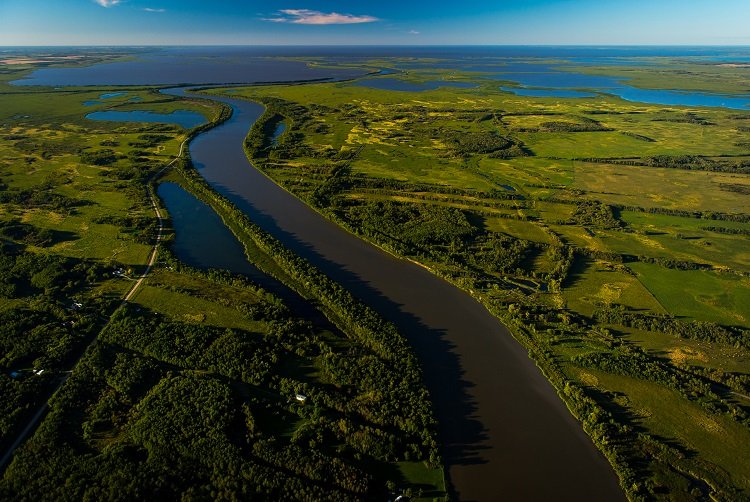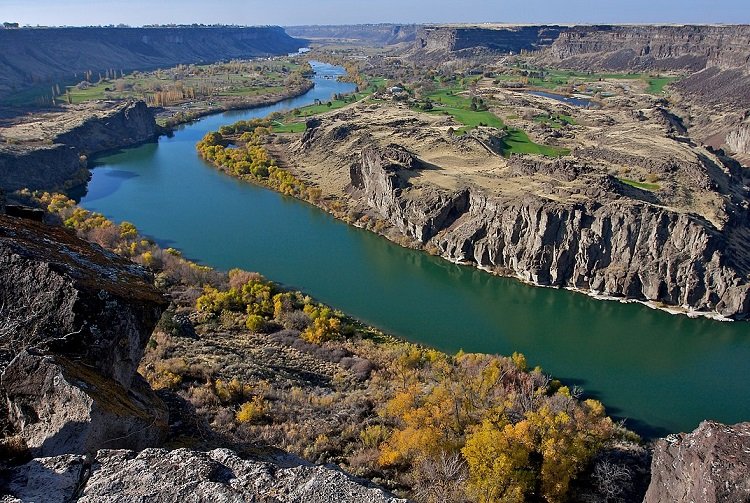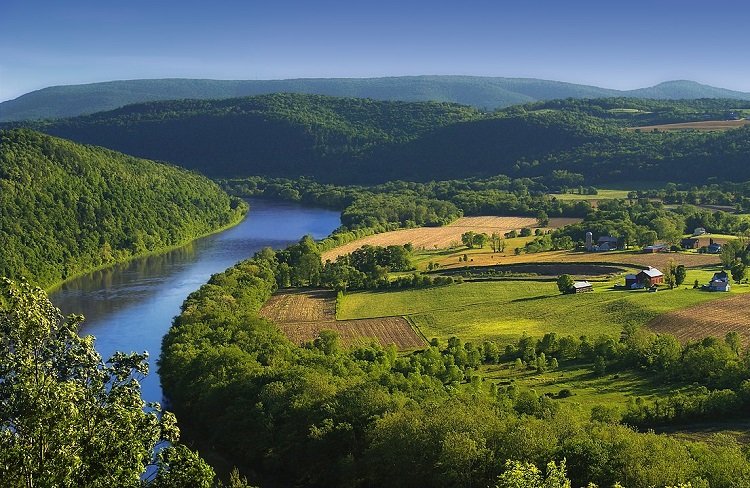The United States is home to some of the deepest rivers in the world. These rivers play an important role in the country’s economy, culture, and ecology. They provide water for irrigation, power for hydroelectric plants, transportation for goods and people, and habitats for fish and wildlife. They also offer recreational opportunities such as fishing, boating, and rafting. The deepest rivers in the US are characterized by their long courses, high discharge, and steep gradients. They are some of the most powerful and awe-inspiring natural features in the country, and they have shaped the landscape, history, and identity of the regions they flow through.
1. Hudson River
The Hudson River is the deepest river in the United States with a maximum depth of 216 feet. The river runs through the northeastern region of the country, stretching 315 miles from the Adirondack Mountains in New York to the Atlantic Ocean. The Hudson River is also known as the “King of American Rivers” and “America’s Rhine”.
See also: 20 Longest Bridges in the US

The Hudson River has played a vital role in the history and development of the northeastern United States. The river has been an important transportation route for both Native Americans and European settlers, and it was used to establish trade and commerce during the colonial era. The Hudson River Valley was a major center of agriculture, manufacturing, and shipping. It also played a key role in the American Revolutionary War as it provided a strategic waterway for the Continental Army and the British Navy.
The Hudson River also serves as an important ecological resource, providing habitats for a wide variety of fish, birds, and other wildlife. The river is home to over 200 species of fish, including shad, striped bass, and American eel, and it is a critical stopover for migrating birds such as the osprey and the bald eagle. It also supports several unique and endangered species. Today, the Hudson River is a popular destination for recreational activities such as boating, fishing, and hiking along the Hudson River Greenway, a scenic trail that stretches for over 150 miles. The river offers some of the best views of the New York City skyline, and it continues to be an important natural feature of the northeastern United States.

2. Mississippi River
The Mississippi River is the second deepest river in the United States, with a maximum depth of 210 feet. The river runs through the central region of the country, stretching for 2,320 miles from its source in Lake Itasca, Minnesota to the Gulf of Mexico. It is the fourth-longest river in the world and the longest in North America.
The Mississippi River also played a significant role in the American Civil War as it provided a strategic waterway for both the Union and Confederate Armies. The river is home to over 300 species of fish, including paddlefish and the endangered pallid sturgeon. It also supports several unique and endangered species. It is also home to several national parks and wildlife refuges, and it continues to be an important natural feature of the central United States.

3. Missouri River
The Missouri River is the third deepest river in the United States, with a maximum depth of approximately 200 feet. It is also one of the longest rivers in North America, stretching over 2,341 miles from its source in the Rocky Mountains of Montana to its confluence with the Mississippi River in Missouri. The Missouri River played a significant role in the westward expansion of the United States, as it was a major transportation route for pioneers and fur traders. Today, the river continues to be an important waterway for commerce, with barges transporting goods such as grain, coal, and petroleum. The river and its surrounding areas are home to a diverse array of wildlife, including bald eagles, river otters, and beavers. Efforts are underway to restore the river’s ecosystem, which has been degraded by human activities such as dam construction and water diversions.
You may also like: Top 12 USA’s Most Fascinating Fishy Friends

4. Yukon River
The Yukon River is the fourth deepest river in the United States, with a maximum depth of approximately 180 feet. It is one of the largest rivers in North America, stretching over 1,980 miles from its source in British Columbia, Canada to its mouth in the Bering Sea in Alaska. The Yukon River played a significant role in the Klondike Gold Rush of the late 1890s when thousands of people flocked to the region in search of gold. Today, the river remains an important transportation route for goods such as fuel and construction materials, as well as a source of hydroelectric power.

5. Rio Grande
The Rio Grande is the fifth deepest river in the United States, with a maximum depth of approximately 150 feet. It is the longest river in Texas and the fourth longest river in the United States, stretching over 1,896 miles from its source in Colorado to its mouth in the Gulf of Mexico. The Rio Grande forms the border between the United States and Mexico and has played an important role in the history of both countries. It is a vital source of water for agriculture and provides habitats for numerous species of plants and animals, including threatened and endangered species such as the ocelot and jaguarundi. The Rio Grande faces numerous environmental challenges, including water scarcity, pollution, and habitat destruction, as a result of increasing demands from agriculture, industry, and urbanization.

6. Colorado River
The Colorado River is the sixth deepest river in the United States, with a maximum depth of approximately 140 feet. It is one of the most significant rivers in the western United States, stretching over 1,450 miles from its source in the Rocky Mountains of Colorado to its delta in Mexico’s Gulf of California. The Colorado River provides water for over 40 million people in seven states and supports a $1 trillion agricultural industry. It also supports diverse wildlife, including endangered species such as the razorback sucker and ponytail chub. However, the river faces numerous challenges including water scarcity, drought, and increasing demands for water from the growing populations and industries. The Colorado River is also impacted by human activities such as dam construction, water diversions, and pollution.
See also: 4 Largest Protected Areas in the United States

7. Arkansas River
The Arkansas River is the seventh deepest river in the United States, with a maximum depth of approximately 120 feet. It is one of the major tributaries of the Mississippi River, stretching over 1,469 miles from its source in the Rocky Mountains of Colorado to its confluence with the Mississippi River in Arkansas. The Arkansas River has played an important role in the settlement and development of the central United States, serving as a transportation route for goods and people, and as a source of irrigation water for agriculture. The river is also impacted by human activities such as dam construction, water diversions, and pollution, and efforts are underway to restore its ecosystem and balance water demands with conservation. The Arkansas River is also recognized for its scenic beauty and is home to several parks and wildlife refuges that provide opportunities for outdoor recreation and wildlife viewing.

8. Red River
The Red River of the North is the eighth deepest river in the United States, with a maximum depth of approximately 100 feet. It is a major tributary of the Mississippi River, stretching over 725 miles from its source in the Red River Valley of Minnesota and North Dakota to its confluence with the Mississippi River in Minnesota. The Red River of the North has played an important role in the settlement and development of the upper Midwest, serving as a transportation route for goods and people, and as a source of irrigation water for agriculture. The river is also recognized for its scenic beauty and is home to several parks and wildlife refuges that provide opportunities for outdoor recreation and wildlife viewing.

9. Snake River
The Snake River is the ninth deepest river in the United States, with a maximum depth of approximately 80 feet. It is a major tributary of the Columbia River, stretching over 1,078 miles from its source in the Rocky Mountains of Wyoming to its confluence with the Columbia River in Washington. The Snake River provides water for irrigation, hydropower generation, and recreational activities, and supports a diverse array of wildlife, including migratory waterfowl, river otters, and beavers.

10. Susquehanna River
The Susquehanna River is the tenth deepest river in the United States, with a maximum depth of approximately 70 feet. It is one of the largest rivers on the East Coast, stretching over 444 miles from its source in New York to its confluence with the Chesapeake Bay in Maryland. The Susquehanna River provides drinking water for millions of people, supports agriculture, and is a source of hydropower.

11. Tennessee River
The Tennessee River is the eleventh deepest river in the United States, with a maximum depth of approximately 60 feet. It is a major tributary of the Ohio River, stretching over 652 miles from its source in the Appalachian Mountains of Tennessee to its confluence with the Ohio River in Kentucky.

12. Kuskokwim River
The Kuskokwim River is the twelfth deepest river in the United States, with a maximum depth of approximately 50 feet. It is a major river in Alaska, stretching over 700 miles from its source in the Alaska Range to its confluence with the Bering Sea. The Kuskokwim River provides water for subsistence and commercial fishing, supports agriculture, and is a source of hydropower. The river is also a critical habitat for a diverse array of wildlife, including salmon, beluga whales, and waterfowl.
See also: Top 5 most beautiful gardens in the US

13. Platte River
The Platte River is the thirteenth deepest river in the United States, with a maximum depth of approximately 40 feet. It is a major river in the Great Plains region, stretching over 300 miles from its source in the Rocky Mountains of Colorado to its confluence with the Missouri River in Nebraska.

14. St. Croix River
The St. Croix River is the fourteenth deepest river in the United States, with a maximum depth of approximately 40 feet. It is a major river in the Midwest, stretching over 250 miles from its source in Wisconsin to its confluence with the Mississippi River in Minnesota. The river is also designated as a National Wild and Scenic River, offering protection for its unique natural and cultural resources.

15. Green River
The Green River is the fifteenth deepest river in the United States, with a maximum depth of approximately 30 feet. It is a major river in the western United States, stretching over 700 miles from its source in Wyoming to its confluence with the Colorado River in Utah.

16. Des Moines River
The Des Moines River is the sixteenth deepest river in the United States, with a maximum depth of approximately 25 feet. It is a major river in the Midwest, stretching over 500 miles from its source in Minnesota to its confluence with the Mississippi River in Iowa.
Excellent